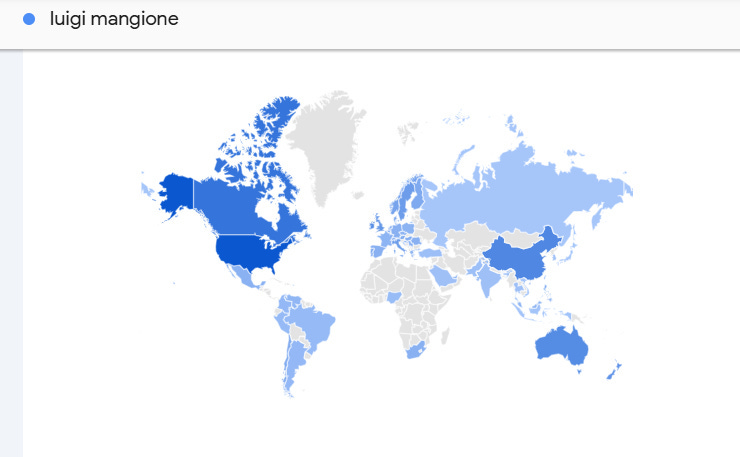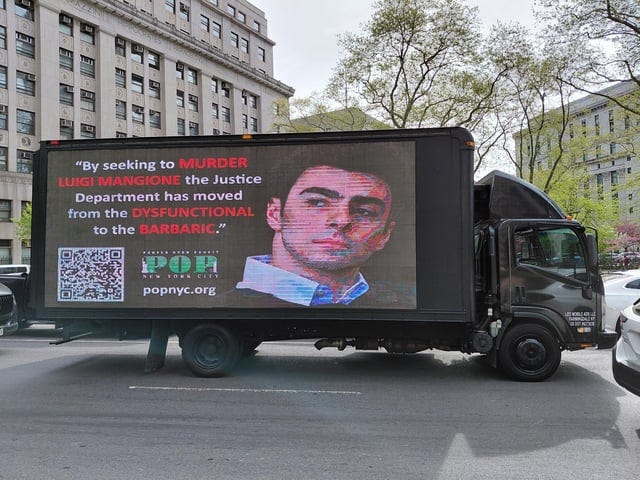Mangione, Act IV: The Architecture of Support
Part 1: Social analysis – Breaking down public support and its ramifications
This series offers a multidimensional analysis of the Luigi Mangione case, examining it from mediatic, legal, political, and cultural angles. Each part delves into a different aspect, uncovering the forces shaping the narrative and public perception around him.
Mangione, Act IV: The Architecture of Support
Mangione, Epilogue: The Rift Before the Trial
The case of Luigi Mangione has not only shocked public opinion, but has also exposed the deep fractures within our concepts of justice, legitimacy, and punishment. The public response has been swift, yet far from uniform—ranging from moral condemnation to an unexpected, even perplexing, wave of support.
How is it possible that someone accused of such a radical act can provoke both institutional revulsion and grassroots support?
This analysis does not pass judgment on Mangione. Instead, we focus on the ecosystem that has formed around him—the various forms of support, from financial contributions to emotional solidarity, and the forces driving them. We will examine this phenomenon through psychological, sociological, and criminological lenses, to understand what is activated in a society when someone, allegedly, challenges deeply entrenched interests. Because when justice becomes spectacle and punishment becomes a message, what is at stake is no longer just an individual: it is the moral and political architecture that sustains our society.
Financial Support: Donations and Legal Defense
The crowdfunding campaign for Mangione’s legal defense reveals a discomforting fracture in public discourse: to what extent can it be considered acceptable to support someone accused of a violent act, particularly when the charges themselves are framed within the context of political theatre? With over $950,218 donated by 26,875 individuals, the vast majority of them anonymous, donations are not a monolith. They are driven by a spectrum of motivations that defy the simplistic logic of blind loyalty or deranged admiration. Some contribute on legal grounds because they believe, without exception, that everyone deserves a fair defense, especially when the charges reek of disproportion or strategic inflation. Others give as a quiet, deliberate form of defiance—resisting a judicial system that long ago ceased to serve the people and began protecting the powerful. The group responsible for starting the fundraiser, who is known as the December 4th Legal Committee, describes its purpose as follows:
We are not here to celebrate violence, but we do believe in the constitutional right of fair legal representation.
Below is what some donors had to say. The donor who contributed the largest sum—$36,500—expressed surprise at the breadth of support, even within corporate circles, where doubt over the prosecution’s conduct and possible overcharging is more common than one might expect. This donor also highlighted the almost universal backing of the suspect, something they found exceptional, given the tendency for such support to be more divided in cases of this nature.
Another example comes from a donor who gave $1,300, stating that it was coincidentally the same amount they were charged for a 100% covered medical procedure. This connection between the amount donated and the personal experience with the healthcare system speaks to a broader frustration with a system that many feel is rigged against ordinary people—an injustice that transcends the courtroom and speaks to a deeply ingrained sense of unfairness in everyday life.
Then there are those who donate from a more visceral place, not always fully articulated. They feel something is off. They sense, perhaps unconsciously, that what’s being judged is not just a man, but a symbolic act that disrupted the habitual alignment between profit, immunity, and impunity.
This mosaic of motivations—rational, emotional, and ideological—reminds us that support is never merely transactional. Rather, it is a complex, expressive act that challenges the very legitimacy of the system in question. The donations to Mangione’s legal defense do not necessarily signal agreement with the alleged act; they reveal something far more unsettling for the establishment: a collective intuition that the system itself is on trial. And in that intuition, in that instinctive recoil from official narratives, we begin to see the outline of a wider unrest—one that no verdict will easily contain.
The “sick donors” narrative and its function
The media responded, as it often does when its role as a moral gatekeeper is threatened: quickly, loudly, and with harsh criticism. Donors to Mangione’s legal fund were immediately labeled as “twisted fans,” “sick donors,” “ghouls” or worse—pathologized and ridiculed into silence. This caricature serves a precise function: it discredits the act of donating before it can be interpreted as anything remotely political, ethical, or legally principled. To donate becomes an act of madness, not meaning.
What gets erased in this simplification is precisely what deserves attention: many of these supporters are not glorifying violence but questioning the monopoly on violence held by the state and its institutions. That the overwhelming majority do not belong to any radical fringe but citizens fed up with watching justice consistently fail upwards. By reducing supporters to freakish anomalies, the media inoculates the public against asking the real questions. Because if a significant number of people are willing to stand behind someone like Mangione—not necessarily because of or in spite of what he did—then maybe, just maybe, it’s the system that’s on trial.
Structural drivers: A crisis of trust and the specter of exemplary punishment
These donations cannot be understood outside the broader architecture of institutional collapse. Faith in the judicial system—already on life support—erodes further with each case that reveals who the law is really designed to protect. In Mangione’s case, the corporate meddling leading to terrorism charges, the theatrical public displays, and the mayor’s self-appointment as moral prosecutor all point to a process less interested in truth than in deterrence. Not a fair trial, but a warning.
There is a growing sense that Mangione is not just being prosecuted—he’s being made into an example. A symbol, not of justice, but of how quickly the state will mobilize its full arsenal when power is threatened, even symbolically. In that context, donating becomes more than a transaction—it’s a signal. A way to say:
We see the overreach. We see the fear behind the theatre.This legal defense fund does not merely finance attorneys. It marks a refusal. A refusal to accept the pre-written script, to nod politely while the machinery of the state stages its performance of order. It is the act of a public no longer convinced that law equals justice. A public that understands that when someone is prosecuted not just for what they’ve done but for what they represent, silence is complicity.

Social media and advocacy support
In today’s digital age, the Mangione case has transcended the courtroom, becoming not just a legal matter but a powerful cultural touchstone that is actively shaped and contested on social media. Platforms like Reddit, Twitter, and TikTok have evolved into battlegrounds where dominant narratives are deconstructed, collective meanings are negotiated, and the official story is constantly questioned.
On Reddit alone, at least 19 subreddits actively discuss the case, with one boasting over 38,000 members. This is no fringe phenomenon—it’s a watchful and organized community, deeply invested in questioning the procedural automation of the criminal justice system. Similarly, on X (formerly Twitter), numerous accounts dedicated to covering the case have appeared, with the most prominent one accumulating almost 44,000 followers. These numbers speak not only to the scale of interest but to the intensity and continuity of the dialogue surrounding the case.
TikTok presents a different dynamic: the struggle to be heard. Accounts posting content critical of the prosecution or supportive of Mangione have been repeatedly banned or suspended, often under vague allegations of violating “community guidelines.” Rather than silencing the conversation, this algorithmic censorship has only fueled the suspicion: if a narrative must be erased, perhaps it’s because it poses an inconvenient truth. What is suppressed, after all, is often what threatens the status quo—and what cannot be said inevitably becomes the focus of public attention.
What’s most striking in this digital conversation is not just the sheer volume of support, but the diversity and depth of it. Across these platforms, Mangione is not merely seen as a defendant; he has become a symbol of collective distrust in institutional authority. True crime enthusiasts, abolitionist thinkers, critical scholars, legal reform advocates, and even those within restorative justice circles have found in his case a reflection of broader systemic fractures.
The stories circulating about Mangione’s case rarely focus on guilt or innocence in the narrow legal sense. Instead, they reflect a broader crisis in societal trust and the growing disillusionment with institutional authority. They center on the perception of a trial deeply influenced by extrajudicial forces—interests that stretch far beyond the courtroom. In these narratives, the trial itself becomes a symbolic purge, not of an individual, but of an interruption to the untouchable dynamics of power, profit, and control.
Psychological and emotional support
The Personal is Political
Recently, writer Ashley Shelby published an article on her Substack about Karen, a 66-year-old woman who supports Mangione. Karen is the mother of a child with a rare illness that caused significant health issues and heavy insurance bills. During their conversation, Karen said, “I am 66... I’ve been living ‘the personal is political’ for as long as I had consciousness of what it meant.”
While the phrase did not originate with second-wave feminism, it is closely associated with it. In this instance, “the personal is political” challenges societal assumptions about women’s behavior. Women supporters, facing the brunt of the media’s sensationalizing of Mangione’s case, inevitably blend the personal with the political. Simply by being women, they are asked to justify whether their support is political or sexual. As they support Mangione, women are portrayed through outdated sexist tropes, those argued to be just facts of life. The truth is, women are practicing resistance to these media portrayals. Including celebrities like Ethel Cain, Lauren Jauregui, and Margaret Cho, use their platforms to advocate for Mangione.
This form of female solidarity doesn’t follow traditional political lines. It’s often chaotic, sometimes contradictory, but deeply charged. For many, Mangione becomes less a figure of self-identification than a symbolic rupture—not because they condone violence, but because they recognize something truthful in what the system’s panic reveals.
Of course, there are dangers in romanticizing a figure like Mangione. The line between empathy and overidentification can blur, simplifying a complex human tendency. However, reducing all expressions of support from women to stereotypical groupie behavior would be a mistake. In a society where channels for dissent are rapidly closing, solidarity—especially women’s solidarity—becomes one of the last available languages of resistance.
Additionally, a poll taken in December 2024 demonstrated that 31% of Black Americans view Mangione favorably, with white people falling in the minority. While I do not intend to diminish the importance of the civil rights movement by comparing it to that of Free Luigi, there are obvious parallels in the way of support. And this poll indicates that while this is a multicultural issue, he receives more support from mainly black and brown people.
Black women were the backbone of the civil rights movement, helping to organize mutual aid, boycotts, educating others, and providing emotional support, among other important contributions to the fight. It is clear now that 21st century women want to participate in modern forms of support, however, not all have been educated on how to properly do so. Fortunately, a simple but meaningful way many have provided support to Mangione is through writing personal letters and providing encouragement. He has even said himself that he appreciates these letters because they are his “means of communication with the outside world.”
Ethical dissonance and collective judgement
After the incident, many people found themselves experiencing an ethical crisis. This sort of crisis was discussed and demonstrated by Trevor Noah on Simon Sinek’s A Bit of Optimism Podcast.
During their conversation, Trevor provides a simplified example of why people support Luigi rather than view Brian Thompson as a victim, to which Simon responds, “What people are missing is that he's not a father or a husband, he's a symbol.” This response highlights how the debate surrounding Mangione’s actions extends far beyond the individual involved. For Simon, the moral complexity is erased by focusing on Mangione's symbolic role in challenging the system. He portrays Mangione as a figure, detached from the real-world consequences of his actions, which simplifies the moral reckoning.
However, Trevor Noah counters this argument, suggesting that many supporters of Mangione are not overlooking his actions, but rather are questioning the broader ethical context within which those actions occurred. In this light, the ethical dilemma is not simply about the legitimacy of violence; it’s about a deeper moral reckoning with a system that continually harms people. Trevor underscores the idea that those who support Mangione may not necessarily condone his actions but are responding to a sense of moral imbalance—something that has been ignored by institutions like the health insurance industry.
This ethical dissonance stems not just from the act itself, but from the frustration with systemic forces perceived as equally culpable. For many, Mangione’s actions symbolize the rupture of a broken system—an act of resistance against an entrenched and exploitative industry. It’s not so much a defense of his choices as much as a questioning of the moral foundations that allow such a system to persist.
This conversation reveals a fundamental shift in how we evaluate ethical responsibility. It’s no longer simply about the individual, but about the systems that shape our moral understanding and the collective consequences of their actions. What Trevor captures in his critique is the ethical tension between upholding traditional moral codes and recognizing the need for systemic change—a conflict that underscores the emotional and psychological turbulence many supporters of Mangione are experiencing.
The loss of Thompson’s life becomes merely a footnote in a larger narrative of collective suffering. And Mangione? He becomes a hero who has slain a dragon.The public’s refusal to perform grief
Hours after Brian Thompson was murdered, corporate-owned media sprang into action—not to investigate, not to ask questions, but to regain control of a story that was slipping through their fingers.
What shocked them wasn’t the killing of a health insurance CEO. It was the public’s response: a collective shrug, followed by a tidal wave of testimony about denial of care, AI-run claim rejections, and the quiet violence of bureaucratic cruelty.¹
In a country splintered by political division, a rare consensus emerged on December 4th, 2024. From MAGA diehards and anarchists to nurses, Redditors, and surgeons, people didn’t respond to Thompson’s death with shock, but with a grim understanding of why someone would be pushed to commit an act of violence. For many, Thompson wasn’t a victim. He was the face of the system that had hurt them.²
This response terrified the ruling class. And in an age when the Fourth Estate has become a franchise of PR firms for billionaires, this sent their media outlets into crisis mode.
Overnight, coverage hardened into a morality play. Thompson wasn’t just a CEO, he was “a devoted father,” “a small-town hero,” “a good man.”³ Mourning him became a test of civic virtue. Anything short of grief was treated as moral perversion.
It didn’t work. When Ben Shapiro tried to brand the killing as “leftist violence” he was rebuked by his own right-wing followers. The public was refusing to mourn the right victim. Media elites couldn’t figure out how to get a framing that dismissed the public’s firsthand experience with health insurance executives to stick.
When the suspect was finally identified, the media had another problem: Luigi Mangione. White. Wealthy. Educated. No criminal record. Good-looking. The optics were all wrong. Had he been poor, brown, an immigrant—ideally all three—the media’s work would’ve been easier.
Instead, they had to attack his privilege. First, he was a textbook narcissist with a God complex. No dice. So they pivoted: Mangione wasn’t “one of us,” op-eds insisted. He was, instead, a “man of privilege who thought he could get away with it.”
Still, the public refused to budge. So the media tried something else: beatify the victim. In a much-mocked New York Times column, Bret Stephens called Thompson a “hometown hero,” highlighting his Iowa roots and hardworking upbringing while glossing over his role in an AI-driven claim denial system and the fact he was being investigated for insider trading.⁵
This didn’t help. Panicked, health insurance executives reportedly pressured the DOJ to pursue the death penalty.⁶
As time went on, donations to Mangione’s legal defense fund surged. That’s when the shaming campaign escalated. Mangione’s supporters were branded “parasocial freaks,” “twisted fans,” “sick donors,” “a ghoul army.”⁷ The goal was clear: discredit them before anyone could ask what they were actually doing, or why. To donate wasn’t just controversial. It was deviant.
But the media and their billionaire owners know better. They know people aren’t idolizing a killer because he killed. It’s that they’ve recognized the systemic violence perpetuated by the wealthy in this country. Thanks to the public accounting online in the days after the murder, we now know this violence touches just about every single non-billionaire American.
Final thoughts: A reflection on the morality of the system
The case of Luigi Mangione is a microcosm of the broader fracture within society, where justice, ethics, and power intersect. What it reveals is not just the motivations behind one man’s actions, but the collective psyche of a society grappling with a system that, for too many, feels rigged, unfair, and opaque.
Support for Mangione transcends simple allegiance. It is a visceral reaction against a system that has long ceased to serve the many, and instead elevates the few. The donations, the social media movements, the grassroots support—they are not an endorsement of violence, but a rejection of a broken system that leaves its citizens with little recourse but to resist.
As we watch this case unfold, it is not just Mangione who is on trial—it is the very architecture of our society, our justice system, and the narratives we have built around power and morality. In the end, what this case forces us to confront is not only the question of guilt or innocence, but the very foundations on which we base our collective judgments and societal structures.
The people are not crying out just for a man, but for change, for repair. It is not just about whether he is guilty or innocent, but about questioning the very foundations on which we build our beliefs about justice and morality.
"Where there is power, there is resistance."
— Michel Foucault
See online testimonies on X (formerly Twitter), Reddit, and TikTok using hashtags like #MangioneTrial, #DeniedByUHC, and #BrianThompson, many of which chronicle denied life-saving procedures and delayed approvals.
Examples include discussion threads on Reddit (e.g., r/Chiraqology and r/antiwork) and call-in shows like Breaking Points and The Majority Report, where callers expressed empathy for Mangione or cited their own insurance trauma.
Obituaries and articles in USA Today, NBC News, and The Des Moines Register emphasized Thompson's small-town Iowa upbringing and family life.
Ben Shapiro's X (Twitter) post dated December 5, 2024, stated: "Let’s be clear: this was a politically motivated killing, the result of years of demonizing health care executives." It was ratioed within an hour.
Bret Stephens’ op-ed in The New York Times, December 14, 2024: “Brian Thompson, Not Luigi Mangione, Is the Hero.
Sources cited by The Intercept and The American Prospect in late January 2025 indicated lobbying activity from health care industry PACs in DOJ deliberations over seeking capital punishment.
See headlines and coverage in The Daily Beast, Rolling Stone, and segments on MSNBC and CNN referring to supporters as “dangerous online cultists,” “deranged fans,” or “digitally radicalized.”














If you find value in this, please share it. Building a critical and informed community is essential to challenging mainstream narratives and truly grasping what’s at stake. Also, feel free to check out our other posts—each one adds a piece to the bigger picture.
really fantastic article! you hit on so many points that really capture the complexity of the supporter base!